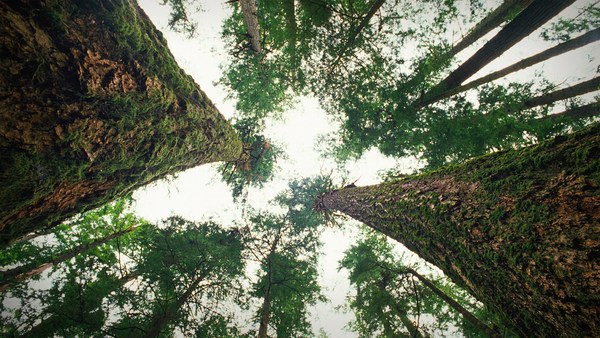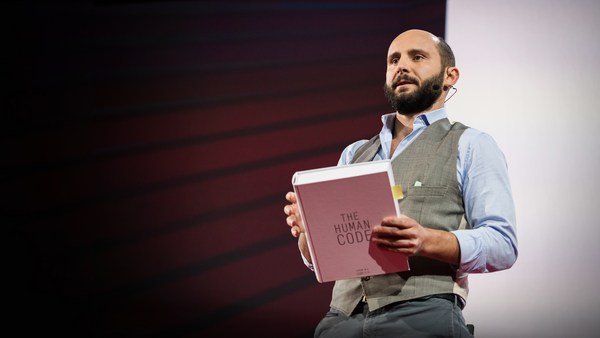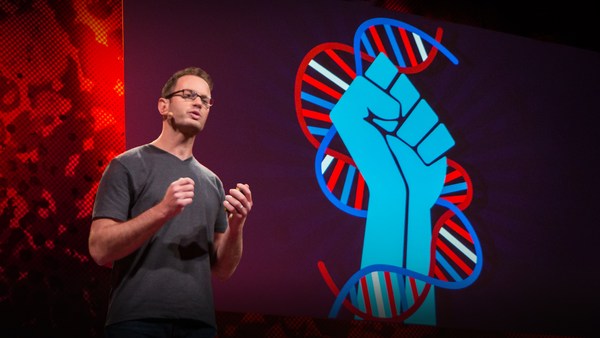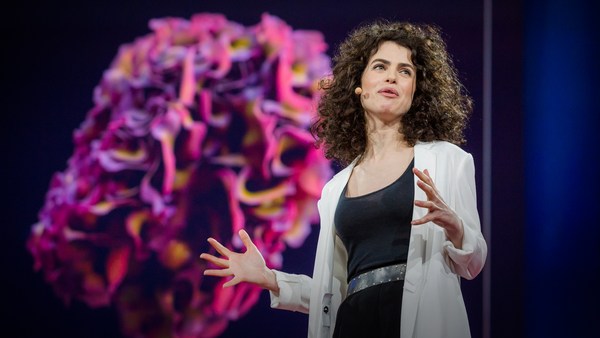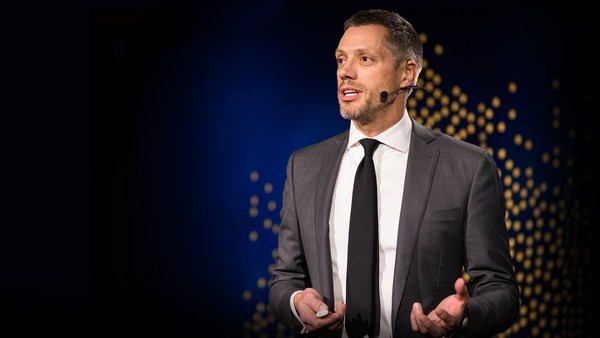Two hundred years of modern science. We have to admit that our performance is not great. The machines we build continue to suffer from mechanical failures. The houses we build do not survive severe earthquakes. But we shouldn't be so critical of our scientists for a simple reason: they didn't have much time. Two hundred years is not a lot of time, while nature had three billion years to perfect some of the most amazing materials, that we wish we had in our possession. Remember, these materials carry a quality assurance of three billion years.
Take, for example, sequoia trees. They carry hundreds of tons for hundreds of years in cold weather, in warm climates, UV light. Yet, if you look at the structure by high-resolution electron microscopy, and you ask yourself, what is it made of, surprisingly, it's made of sugar. Well, not exactly as we drink in our tea. It's actually a nanofiber called nanocrystalline cellulose. And this nanocrystalline cellulose is so strong, on a weight basis, it's about 10 times stronger than steel. Yet it's made of sugar.
So scientists all over the world believe that nanocellulose is going to be one of the most important materials for the entire industry. But here's the problem: say you want to buy a half a ton of nanocellulose to build a boat or an airplane. Well, you can Google, you can eBay, you can even Alibaba. You won't find it. Of course, you're going to find thousands of scientific papers -- great papers, where scientists are going to say this is a great material, there are lots of things we can do with it. But no commercial source.
So we at the Hebrew University, together with our partners in Sweden, decided to focus on the development of an industrial-scale process to produce this nanocellulose. And, of course, we didn't want to cut trees. So we were looking for another source of raw material, and we found one -- in fact, the sludge of the paper industry. The reason: there is a lot of it. Europe alone produces 11 million tons of that material annually. It's the equivalent of a mountain three kilometers high, sitting on a soccer field. And we produce this mountain every year. So for everybody, it's an environmental problem, and for us, it's a gold mine.
So now, we are actually producing, on an industrial scale in Israel, nanocellulose, and very soon, in Sweden. We can do a lot of things with the material. For example, we have shown that by adding only a small percent of nanocellulose into cotton fibers, the same as my shirt is made of, it increases its strength dramatically. So this can be used for making amazing things, like super-fabrics for industrial and medical applications. But this is not the only thing. For example, self-standing, self-supporting structures, like the shelters that you can see now, actually are now showcasing in the Venice Biennale for Architecture.
Nature actually didn't stop its wonders in the plant kingdom. Think about insects. Cat fleas, for example, have the ability to jump about a hundred times their height. That's amazing. It's the equivalent of a person standing in the middle of Liberty Island in New York, and in a single jump, going to the top of the Statue of Liberty. I'm sure everybody would like to do that. So the question is: How do cat fleas do it?
It turns out, they make this wonderful material, which is called resilin. In simple words, resilin, which is a protein, is the most elastic rubber on Earth. You can stretch it, you can squish it, and it doesn't lose almost any energy to the environment. When you release it -- snap! It brings back all the energy. So I'm sure everybody would like to have that material. But here's the problem: to catch cat fleas is difficult.
(Laughter)
Why? Because they are jumpy.
(Laughter)
But now, it's actually enough to catch one. Now we can extract its DNA and read how cat fleas make the resilin, and clone it into a less-jumpy organism like a plant. So that's exactly what we did. Now we have the ability to produce lots of resilin.
Well, my team decided to do something really cool at the university. They decided to combine the strongest material produced by the plant kingdom with the most elastic material produced by the insect kingdom -- nanocellulose with resilin. And the result is amazing. This material, in fact, is tough, elastic and transparent. So there are lots of things that can be done with this material. For example, next-generation sport shoes, so we can jump higher, run faster. And even touch screens for computers and smartphones, that won't break.
Well, the problem is, we continue to implant synthetic implants in our body, which we glue and screw into our body. And I'm going to say that this is not a good idea. Why? Because they fail. This synthetic material fails, just like this plastic fork, that is not strong enough for its performance. But sometimes they are too strong, and therefore their mechanical properties do not really fit their surrounding tissues.
But in fact, the reason is much more fundamental. The reason is that in nature, there is no one there that actually takes my head and screws it onto my neck, or takes my skin and glues it onto my body. In nature, everything is self-assembled. So every living cell, whether coming from a plant, insect or human being, has a DNA that encodes for nanobio building blocks. Many times they are proteins. Other times, they are enzymes that make other materials, like polysaccharides, fatty acids. And the common feature about all these materials is that they need no one. They recognize each other and self-assemble into structures -- scaffolds on which cells are proliferating to give tissues. They develop into organs, and together bring life.
So we at the Hebrew University, about 10 years ago, decided to focus on probably the most important biomaterial for humans, which is collagen. Why collagen? Because collagen accounts for about 25 percent of our dry weight. We have nothing more than collagen, other than water, in our body. So I always like to say, anyone who is in the replacement parts of human beings would like to have collagen.
Admittedly, before we started our project, there were already more than 1,000 medical implants made of collagen. You know, simple things like dermal fillers to reduce wrinkles, augment lips, and other, more sophisticated medical implants, like heart valves. So where is the problem? Well, the problem is the source. The source of all that collagen is actually coming from dead bodies: dead pigs, dead cows and even human cadavers. So safety is a big issue. But it's not the only one. Also, the quality.
Now here, I have a personal interest. This is my father, Zvi, in our winery in Israel. A heart valve, very similar to the one that I showed you before, seven years ago, was implanted in his body. Now, the scientific literature says that these heart valves start to fail 10 years after the operation. No wonder: they are made from old, used tissues, just like this wall made of bricks that is falling apart. Yeah, of course, I can take those bricks and build a new wall. But it's not going to be the same. So the US Food and Drug Administration made a notice already in 2007, asking the companies to start to look for better alternatives.
So that's exactly what we did. We decided to clone all the five human genes responsible for making type I collagen in humans into a transgenic tobacco plant. So now, the plant has the ability to make human collagen brand new, untouched. This is amazing. Actually, it's happening now. Today in Israel, we grow it in 25,000 square meters of greenhouses all over the country. The farmers receive small plantlets of tobacco. It looks exactly like regular tobacco, except that they have five human genes. They're responsible for making type I collagen. We grow them for about 50 to 70 days, we harvest the leaves, and then the leaves are transported by cooling trucks to the factory. There, the process of extracting the collagen starts.
Now, if you ever made a pesto -- essentially, the same thing.
(Laughter)
You crush the leaves, you get the juice that contains the collagen. We concentrate the protein, transfer the protein to clean rooms for the final purification, and the end result is a collagen identical to what we have in our body -- untouched, brand new and from which we make different medical implants: bone void fillers, for example, for severe bone fractures, spinal fusion. And more recently, even, we've been able to launch into the market here in Europe a flowable gel that is used for diabetic foot ulcers, that is now approved for use in the clinic.
This is not science fiction. This is happening now. We are using plants to make medical implants for replacement parts for human beings. In fact, more recently, we've been able to make collagen fibers which are six times stronger than the Achilles tendon. That's amazing.
Together with our partners from Ireland, we thought about the next thing: adding resilin to those fibers. By doing that, we've been able to make a superfiber which is about 380 percent tougher, and 300 percent more elastic. So oddly enough, in the future, when a patient is transplanted with artificial tendons or ligaments made from these fibers, we'll have better performance after the surgery than we had before the injury.
So what's for the future? In the future, we believe we'll be able to make many nanobio building blocks that nature provided for us -- collagen, nanocellulose, resilin and many more. And that will enable us to make better machines perform better, even the heart. Now, this heart is not going to be the same as we can get from a donor. It will be better. It actually will perform better and will last longer.
My friend Zion Suliman once told me a smart sentence. He said, "If you want a new idea, you should open an old book." And I'm going to say that the book was written. It was written over three billion years of evolution. And the text is the DNA of life. All we have to do is read this text, embrace nature's gift to us and start our progress from here.
Thank you.
(Applause)
